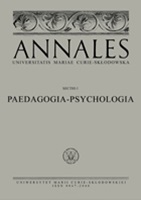Wypalenie zawodowe pracowników socjalnych jako efekt stresu zawodowego
Professional Burnout of Social Workers as a Result of Occupational Stress
Author(s): Katarzyna NowosadSubject(s): Social psychology and group interaction, Personality Psychology, Family and social welfare, Welfare services
Published by: Wydawnictwo Naukowe Uniwersytetu Marii Curie-Sklodowskiej
Keywords: social worker; burnout; occupational stress; emotional burden;
Summary/Abstract: Social worker is one of the professions particularly vulnerable to burnout. This is due to the helping nature of the work, which causes an emotional burden resulting from the client’s growing expectations and often limited possibilities of fulfilling them, as well as from the sense of responsibility for the client’s fate. Moreover, social workers are aware of their moral responsibility for the decisions they make towards their own conscience, the client, the work environment or their superiors, as well as awareness of legal responsibility. Their occupational stress is often intensified by the need to enter the extremely sensitive, difficult and often complex sphere of their clients, because they are witnesses of human misfortunes, their learned helplessness or adaptation difficulties that make it impossible to function socially or effectively perform parental roles. Sometimes social workers become victims of aggression from demanding clients. The aim of the research was to determine the relationship between the burnout of the surveyed social workers, manifested in its various dimensions, and the level of their general occupational stress. In solving the main research problem, first of all, the diagnosis of burnout of the surveyed social workers (explained variable) was made. For this purpose, the LBQ Questionnaire (Santinello) was used, which is the Polish adaptation of the Italian Link Burnout Questionnaire (LBQ). The occupational stress of the surveyed employees (explanatory variable) was determined by using the Stress Feeling Questionnaire. An additional dimension was introduced into the questionnaire – a lie scale, which can serve as a reliable tool for the initial verification of the respondents’ statements. The statistical analyzes performed confirmed the adopted hypothetical assumptions about a statistically significant positive correlation between the two variables. For this reason, this issue requires constant research and analysis as well as adequate preventive actions. The article is one of the attempts to diagnose this phenomenon and contains specific conclusions that are not only cognitive but also utilitarian.
Journal: Annales Universitatis Mariae Curie-Skłodowska. Sectio J. Paedagogia-Psychologia
- Issue Year: 37/2024
- Issue No: 1
- Page Range: 247-268
- Page Count: 22
- Language: Polish

